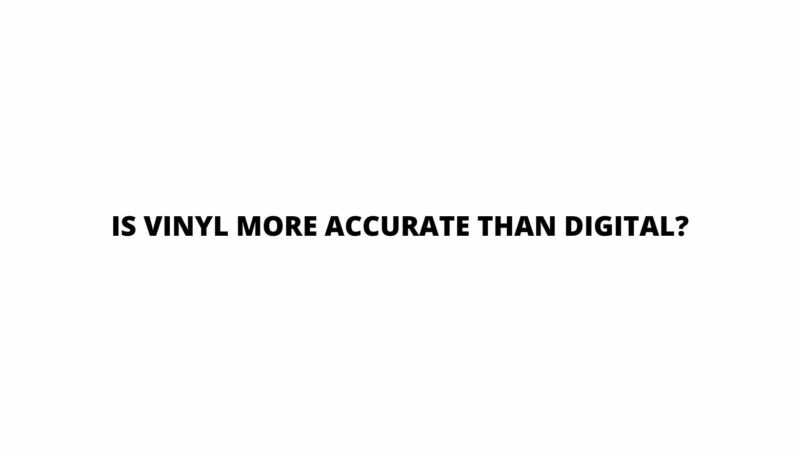The eternal tug-of-war between analog and digital audio has sparked countless debates among audiophiles and music enthusiasts. At the heart of this discourse lies the question: Is vinyl more accurate than digital? The comparison between these two realms of audio reproduction isn’t merely a clash of technologies; it’s a journey that traverses the intricacies of sound, technology, and perception. In this article, we delve into the nuances of accuracy in both vinyl and digital audio, exploring the technical foundations, the subjective listening experience, and the unique qualities that each format brings to the sonic table.
Vinyl’s Analog Charm
Vinyl records offer a connection to music that extends beyond auditory sensation. The tactile experience of handling records, the ritual of placing the needle on the groove, and the nostalgic crackling that accompanies playback evoke a sensory intimacy that digital formats often struggle to replicate. However, does this analog charm translate to greater accuracy in sound reproduction?
- Groove Dynamics: Vinyl’s accuracy hinges on the delicate interplay between the stylus and the grooves. The physical grooves etched onto vinyl records mirror the original sound waves, capturing nuances in amplitude and frequency. Each groove serves as a direct imprint of the sound, offering a unique representation of the original performance. While this process may seem more “analogous” to the natural sound, it’s also influenced by various factors such as stylus quality, tracking force, and turntable mechanisms.
- Warmth and Depth: Vinyl is often associated with warmth and depth in sound, attributed to the inherent analog nature of the medium. The continuous variation in groove depth allows for a certain natural compression that contributes to the richness of the sound. This perceived “accuracy” can be subjective, as it depends on the listener’s preference for this specific tonal quality.
- Imperfections as Art: Vinyl records are not without imperfections—surface noise, pops, and crackles. Paradoxically, these imperfections are part of vinyl’s allure. They contribute to the organic, textured, and almost human quality of the sound. While these imperfections may stray from technical accuracy, they also add a unique layer of authenticity to the listening experience.
Digital’s Precise Reproduction
Digital audio, on the other hand, is often hailed for its precision and consistency. The binary nature of digital data means that audio is represented as a series of discrete values—samples—capturing sound at regular intervals. This process is designed to capture the audio waveform as faithfully as possible. However, the accuracy of digital audio isn’t without its complexities and considerations.
- Sampling Rate and Bit Depth: The accuracy of digital audio is determined by its sampling rate and bit depth. A higher sampling rate captures more detail from the original sound wave, while a higher bit depth provides greater resolution in representing the amplitude of the sound. The combination of these factors contributes to the accuracy of digital sound reproduction.
- Lossless Compression: Lossless compression algorithms, used in formats like FLAC and ALAC, reduce file sizes without sacrificing audio quality. This means that the playback is a perfect replica of the original recording, maintaining accuracy.
- Consistency and Reproducibility: Digital audio playback is consistent across different devices and systems. A digital file played on one device will sound the same when played on another device with the same specifications. This level of consistency contributes to the perception of accuracy in digital audio.
The Listener’s Role: Subjective Perception
The accuracy debate is significantly influenced by the listener’s perception and preference. Some listeners are drawn to the tactile engagement and natural warmth of vinyl, while others appreciate the clarity and fidelity of digital sound. Our perception of accuracy is subjective and influenced by factors such as individual taste, auditory sensitivity, and the context in which we listen.
Furthermore, personal biases and expectations play a significant role in how we perceive accuracy. If a listener has grown accustomed to the sound of vinyl, they might perceive digital sound as cold or clinical. Conversely, a listener who has been exposed to pristine digital sound might find vinyl’s imperfections distracting.
The Role of Music Production and Mastering
It’s important to note that the accuracy of both vinyl and digital audio is contingent on the quality of music production and mastering. A well-mastered digital track can offer exceptional accuracy, just as a carefully mastered vinyl release can capture the nuances of the original performance.
Conclusion
The question of whether vinyl is more accurate than digital is multifaceted, bridging the realms of science, perception, and artistic intent. The perceived accuracy of each format is colored by factors such as groove dynamics, warmth, bit depth, and sampling rate. However, it’s crucial to recognize that “accuracy” isn’t an absolute measure—it’s a subjective perception influenced by individual preferences, listening environments, and cultural contexts.
The beauty of this debate lies in the diversity it brings to the world of audio appreciation. Vinyl and digital audio coexist as distinct mediums, each with its unique strengths and qualities. The vinyl’s analog charm and imperfections are as much a part of its allure as digital’s precision and consistency. In the end, the quest for accuracy in audio is a dynamic and evolving journey, guided by our ever-changing ways of experiencing and interpreting sound.


